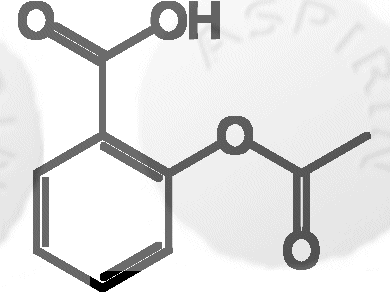Classical and New Uses
Exciting? It is widely used as an analgesic, antipyretic, and anti-inflammatory drug, but what is exciting about aspirin?
On the one hand, it is the best-known and the most widely used medicine in the world: 100 billion (109) aspirin pills, weighing 400,000 t, are swallowed yearly on Earth and in the space stations. Also its age inspires respect: it is one of very few drugs of the 19th century still used today.
On the other hand, the range of its applications is much wider than the standard few. Currently, it is believed that a small daily dose of aspirin can not only prevent blindness and kidney damage in people with diabetes as well as prevent heart attacks and stroke in men, but it can also act against miscarriages. Evidence was also found for the beneficial effect of preventing different types of cancer and for their treatment. Based on the analysis of medical data of 25,000 patients collected over many years, it was found that taking aspirin for at least five years lowered the risk of several types of cancer, including those of the lung, prostate, breast, colon, esophagus, stomach, colon, bladder, kidney, gall bladder, and brain. It also reduces the likelihood of occurrence of distant metastasis in humans.
However, you should be aware of the existence of restrictions on the long-term use of aspirin because it can cause bleeding in the gastrointestinal tract and causes blood thinning.
Through the use of aspirin to prevent and treat diseases other than those for which it has been used for centuries, the drug fits into one of the most current trends in pharmacy: The search for applications of known medications for the treatment of diseases other than those for which they were once developed.
Synthesis
The active substance in aspirin is a synthetic derivative of salicin – aspirin. Salicin is a compound that occurs in plants, including willow bark and meadowsweet (Filipendula ulmaria). The analgesic effects of willow juice were described in an Egyptian papyrus from about 1550 BC. It was also used in Assyria and ancient China and Greece. The juice was also applied by the fathers of medicine Hippocrates (ca. 460 BC – 370 BC) and Pliny the Elder (23 AD – 79 AD). Medieval quacks used it as an ingredient in herbal infusions.
The synthesis of aspirin or acetylsalicylic acid can be executed by several methods, but only Felix Hoffmann from Bayer AG obtained it in a form suitable for use as a medication in 1897. The discovery and synthesis of aspirin was also claimed by his boss Arthur H. Dreser Eichengrün who, over 50 years after the Hoffmann work, published a paper in which he insisted that he ordered Hoffmann to execute this synthesis. As in many cases, success has more than one father.
Despite the widespread use of aspirin, its mechanism of action was unclear for a long time. Only the work of John Vane, awarded the Nobel Prize in medicine in 1982, showed that aspirin blocks the production of natural hormones, in particular, prostaglandin thromboxane active in the production of blood clots. In this way, it acts wherever clots block or can block the blood vessels.
Drug Modeling and Non-medical Applications
Today, the development of new drugs requires anywhere from 12 to even 20 years of research and costs from 300 million up to a billion dollars. It includes pre-clinical studies, when approximately 1,000 ‘hits’ are selected from a set containing 50,000 to 5 million compounds. These are the compounds hoped to have the desired therapeutic effect. Thus, one needs to get (mainly through synthesis) thousands of molecules, purify them, then examine their properties and see if they actually have the desired pharmacological effect.
To simplify the maze of finding the most promising substances, a large part of research is currently carried out using “dry chemistry”, that is computational methods also called ‘in silico’ research. There, the methods of computer modeling of the active site and its interactions with prospective drugs are applied. The model of the site is built up, based on the knowledge of the active center usually obtained by X-ray analysis. Then one tries to match the model with a molecule that should have the desired properties.
Another approach is based on the huge collected experimental data QSAR (Quantitative Structure Activity Relations) making use of the quantitative relationship between the structure of molecules and their pharmacological properties. The application of theoretical methods can significantly reduce the cost of drug development by reducing the number of molecules as drug candidates.
Applications of aspirin are not limited to drugs. Contaminated soil can be decontaminated of fungi by spraying it with a solution of aspirin in water (1 tablet per liter of water, the concentration is important because a solution that is too strong can “burn” the leaves of plants). An aqueous solution of aspirin can also be a treatment for dandruff and pimples, remove nicotine stains from fingers and sweat from T-shirts, and extend the freshness of cut flowers.
Thus, good old aspirin is experiencing a second youth, and the range of its applications is constantly increasing.
Author
Professor Helena Dodziuk, Warsaw, Poland
Also of Interest
- Women in Chemistry — Interview with Helena Dodziuk,
Vera Köster,
ChemistryViews 2011.
DOI: 10.1002/chemv.201000114
H. Dodziuk, Polish Academy of Sciences, works on molecules with interesting topography and strained hydrocarbons with unusual spatial structures



I already comments that this is very interesting articles but inside the text lacking references. it must be references fol all information like new uses of aspirin.